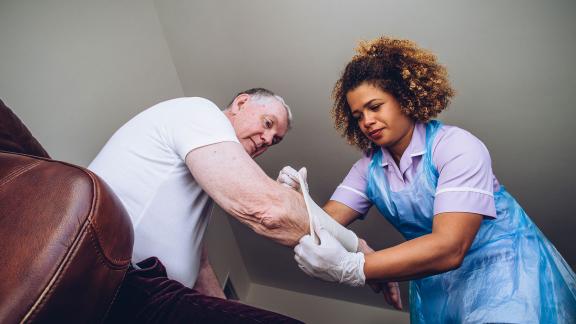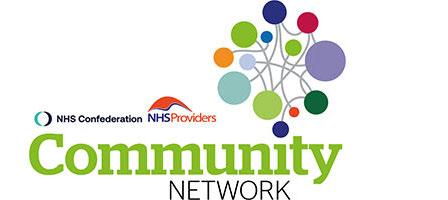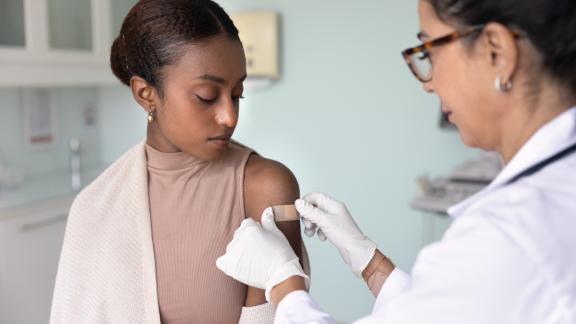Boosting referrals into urgent community response services to benefit patients
Key points
Integrated care boards, community providers and primary care providers have been asked to increase the volume and consistency of referrals into urgent community response (UCR) services to improve patient care, ease pressure on ambulance services and avoid admissions.
Community providers are already working hard to scale up their UCR services and have been very successful in helping people access care at home, making swift progress since NHS England introduced a national direction to ensure a greater degree of consistency across these services.
However, Community Network members say there is scope to go further to drive up the number of patients who benefit from UCR services, including through boosting referrals into the service from key system partners.
There is a role for both systems and national policymakers in supporting this and in encouraging system partners to work collaboratively on a vision and strategy for increasing referrals to UCR services.
A more robust national dataset would support both providers and the national team to benchmark activity levels and understand where more work is needed to increase referrals.
Further work to develop local relationships, as well as national support to tackle issues around information governance and data sharing, are central to moving these processes forward.
Greater prioritisation and investment at national and local levels remains important to ensure community providers are appropriately resourced to meet demand for UCR services.

This briefing from the Community Network, hosted by the NHS Confederation and NHS Providers, explores what can be done to increase further the number of patients who benefit from urgent community response services, including through boosting referrals from key system partners.
Overview
Urgent community response (UCR) services deliver rapid response care to patients in the community within two hours of receiving a call and will play a central role in improving care and managing system-wide pressures this winter and beyond. Over the past few years, community providers have made significant progress in scaling up these services in line with national targets and NHS England’s urgent and emergency care plan. Leaders and staff in community providers remain ambitious about the potential to expand these services for patients.
UCR services ensure people receive the right care quickly in their own home. This can reduce the need for patients to use urgent and emergency care (UEC) pathways; reduce pressures on ambulance services and A&E departments, contributing to better and more timely care for patients; and improved patient flow through the whole health and care system.
NHS England has recently increased its focus on the role of UCR through national guidance, including the winter plan for 2023/24. As part of the ten high-impact interventions outlined within the document, integrated care boards (ICBs), community providers and primary care providers have been asked to increase the volume and consistency of referrals into UCR services to ‘improve patient care and ease pressure on ambulance services and avoid admission’.
Across the country, there are already examples of community providers working effectively with partners to do this, and to maximise the benefits of UCR services for patients and system flow. We previously set out the importance of UCR services in our report, Making the Most of Urgent and Community Response Services, and highlighted ways community providers are delivering UCR services. However, there is scope to go further faster.
As we look towards winter, this is a timely moment to share good practice and reflect on how national leaders, systems and community providers can ensure that these vital services are delivering maximum value to the health and care system, including colleagues in the ambulance sector and, most importantly, to patients.
The benefits of UCR services: providing the right care, at the right time, in the right place
Hospital is not always the most appropriate place for patients to receive care, neither is it always necessary for an ambulance to be dispatched to offer an urgent response. In many cases, people can be effectively cared for at home or in the community. This is particularly true for those who are frail and/or managing long-term and often complex health conditions.
Multidisciplinary UCR teams deliver holistic, wraparound care for individuals. They are well-placed to monitor patients for a short period of time after a fall or minor illness and can make arrangements to support ongoing care needs
Progress scaling up the delivery of UCR services
Community providers are working towards optimising the benefits of UCR services for patients and system flow. The national target of responding to 70 per cent of UCR referrals within two hours has been met consistently since it started in April 2022, and the number of referrals has increased over the last year. With demand on UEC pathways particularly high, UCR services have the potential to play a greater role with the right resources.
UCR services form a crucial part of the long-term vision of community care. Leaders and staff within community providers are ambitious about the potential of these services and say there is scope to continue driving up the number of patients who benefit from UCR services, including through boosting referrals into the service from key system partners.
According to the latest national data, there were 73,455 referrals to UCR services in October 2023. Of this number, 37.5 per cent of referrals came from the person themselves, their carer or relative, while only 15.6 per cent came from a general medical practitioner practice and 8.4 per cent from an ambulance service. This reflects feedback from Community Network members that there is more scope to increase the number of referrals from system partners to UCR services, and a role for both systems and national policymakers in supporting this. This reflects feedback from Community Network members that there is more scope to increase the number of referrals from system partners to UCR services, and a role for both systems and national policymakers in supporting this.
Key enablers for increasing referrals into UCR services
Greater understanding of UCR services across system partners
At a local level, many community providers are actively engaging with colleagues from the ambulance sector and primary care to promote the UCR services being delivered in their area, and boost confidence in making referrals.
Some providers are working with higher education institutions, hospices, GPs and the ambulance sector to outline their support offer through face-to-face meetings, sharing learning and resources to demonstrate the benefits of UCR for patients and system flow. Providers are also inviting key partners to attend weekly UCR leadership meetings to increase exposure to the service, which can help to improve understanding of these services and encourage partners to refer into them more routinely.
National guidance for the delivery of UCR services clearly outlines the clinical requirements for how and when the service should be used by the public and by health and care partners. But a degree of flexibility is built in and this can create challenges, especially for partners working across multiple systems.
For example, ambulance sector partners often deliver care across multiple ICSs with different UCR offers. Some UCR services deliver care from 8am to 8pm, as outlined in the national guidance, while others already provide care 24 hours a day. Promoting UCR services at both a national and local level with support for system partners to better understand different local offers, and how these services can be used, is key to boosting the number of referrals.
ICSs can play a key role in encouraging system partners to work collaboratively to develop a vision and strategy for increasing referrals to UCR services
Understanding how clinical risk is shared between partners is another important part of the puzzle. For example, care home staff or ambulance call handlers might default to dispatching an ambulance if they do not have a clear understanding of the support UCR services can deliver, or confidence about the way that clinical risk is shared between key partners. Alongside leaders from community providers and ambulance trusts, ICSs can play a key role in encouraging system partners to work collaboratively to develop a vision and strategy for increasing referrals to UCR services. They can also facilitate open and transparent conversations about quality, patient safety and risk sharing between key partners.
Robust UCR data and a clearer national ask
At present, NHS England collects data on the number of UCR referrals, alongside the referral source and reason, as part of its UCR monitoring dashboard. While this represents an important step forward in the collection of national community data, there remains significant variation in the number of UCR referrals being recorded in each ICS. Some variation is to be expected, with rapid response services having been established for different lengths of time across the country, alongside different local geographies and demographics. However, the level of variation we see in the current national data indicates that providers are recording UCR referral activity differently.
Community providers would therefore welcome the opportunity to work with NHS England to clarify the activity that should be recorded as part of national UCR submissions. This would help create a more robust national dataset to support both providers and the national team to benchmark activity levels and understand where further work is needed to increase referrals into UCR services. Linked to this, a target for the number of UCR referrals an ICS should be aiming for based on population size could support a better understanding of local referral rates and capacity, as well as creating a clear vision and ambition for systems to invest in these services.
While greater national direction around developing more robust UCR data would be valuable, health and care support for patients who are frail or are managing long-term health conditions can be complex, as well as challenging to reflect accurately in a single performance metric. In the longer term, there is scope for a national evaluation of the benefits of UCR services for patients and other parts of the health and care system, taking into account the nuance and complexities of measuring the impact of ongoing care.
Trusted relationships and collaboration
Trusted relationships between community providers and colleagues in primary care and the ambulance sector are key to increasing confidence in making referrals into UCR services. Across the country, community providers are working effectively with ambulance sector colleagues to co-locate ambulance and UCR teams. This allows a multi-disciplinary team, often including a paramedic, to physically view the call stack together and determine which patients can best be supported by UCR services. This reduces duplication and streamlines the referral process, as well as supporting cross-sector collaboration and relationship building.
Some UCR teams have developed a single point of access (SPA) hub, which patients and system partners can call to make a referral into their local UCR service
Some UCR teams have also developed a single point of access (SPA) hub, which patients and system partners can call to make a referral into their local UCR service. Patients are then triaged by the UCR team to determine which healthcare professional can best support the individual. SPAs support the seamless referral of patients into UCR services, again reducing the risk of duplication and supporting system-wide collaboration.
However, barriers to increasing referrals into UCR services remain. For instance, challenges around information governance and data sharing between key partners can make it difficult to increase referrals. While progress has been made around collaboration with partners, in most cases community teams cannot directly access calls made to 999 services and assess which could be appropriately diverted to UCR services. This means there is often an additional step between a patient requesting support and the call being diverted into a UCR team. Further work to develop local relationships, as well as national support to tackle issues around information governance and data sharing, are central to moving these processes forward with a view to increasing referrals to UCR services.
Finally, it’s important to acknowledge that UCR services are operating at different levels of maturity and capacity in different parts of the country. Community provider leaders report that a dialogue about the role of UCR services in local systems is important, as are open and honest conversations about the challenges to scaling up services and what can be done to address them meaningfully.
Getting investment and staffing right
At a local level, community providers are considering how staff can play a central role in optimising UCR capacity. For example, one community provider reports recruiting more staff to deliver administrative support within their UCR team, with a view to increasing clinical capacity by 25 per cent. Community providers are doing this in response to significant staff shortages across the sector, for example with the number of district nurses falling by almost 43 per cent between 2009 and 2019. Despite the national policy shift towards providing more care in the community through initiatives such as UCR, the number of community staff has not kept pace with these ambitions or with increased demand for services.
...this ambition for the sector must be accompanied by a robust implementation strategy to break down the existing barriers to recruitment and retention in the community sector
The Community Network welcomed the NHS Long Term Workforce Plan’s (LTWP) commitment to growing the community workforce, with the total community workforce expected to double in size by 2036/7. We also welcomed the focus on multidisciplinary teams, which play an essential role in delivering more integrated care for patients through services such as UCR. However, this ambition for the sector must be accompanied by a robust implementation strategy to break down the existing barriers to recruitment and retention in the community sector. Meeting the targets set out in the plan will require greater prioritisation of community roles, showcasing the rewarding work that can be delivered through new models of care including UCR services. We also look forward to confirmation from the government as to when the funding committed for the LTWP will be released for the sector.
In a financially constrained environment, and without ringfenced funding for the sector, there are concerns that the community sector will be squeezed out of system-level investments. However, to realise the potential of UCR services, funding for the community sector must be prioritised. There is a clear role for ICSs in directing resource at a local level to ensure community providers are properly resourced to deliver more care in the community. This will in turn alleviate pressures on the wider health and care system, and particularly urgent and emergency pathways.
It is clear that efforts to boost referrals into UCR teams and maximising capacity must be underpinned by having the right number and mix of staff, as well as sufficient investment in community services. Without this, it will be difficult to optimise the potential of UCR services and ensure that they can manage any increase in referrals effectively and sustainably.
Recommendations
Community providers are already working hard to scale up their UCR services both for the benefit of patients and system flow, having made swift progress since NHS England introduced a national direction to ensure a greater degree of consistency across these services. Amid significant operational pressures, impressive progress has been made over the last couple of years to meet national targets.
But community providers are ambitious about going further, faster and are striving to develop services and increase referrals by working closely with system partners. As providers and systems look to expand the delivery of UCR services, there are several national and local enablers that can help to increase the number of referrals into the service:
- NHS England and system partners, including community providers, should raise awareness of UCR services at both a national and local level to support system partners to better understand how and when they should be used and to foster trusting relationships at local levels. Ensuring clinical leadership and buy in from community providers, social care, primary care and the ambulance sector remains particularly important.
- NHS England could use enablers, including the forthcoming planning guidance, to build greater system-level alignment in order to deliver more care in the community.
- The Community Network would welcome the opportunity to work with NHS England colleagues to review and co-produce further guidance on what should be recorded as part of national UCR data to address challenges around variation in referral rates.
- NHS England should commission a national evaluation of the benefits and outcomes of increased usage of UCR services, both for patients and wider health and care services.
- Greater prioritisation and investment in UCR services by both national government and local systems is key to ensuring community providers are appropriately resourced to meet demand.




